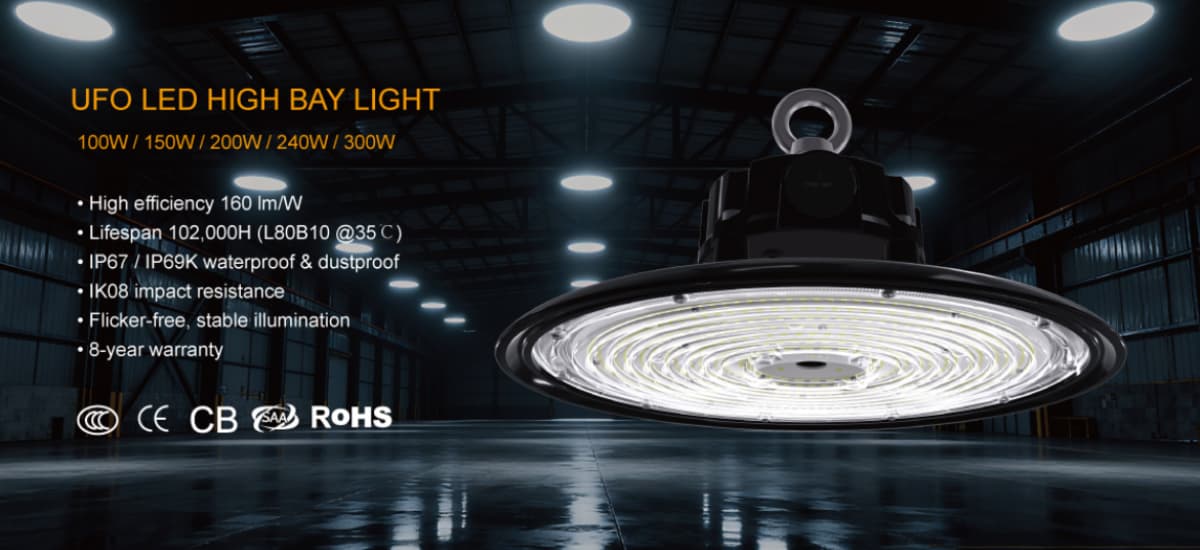What Is New in Industrial LED Lighting in 2025?
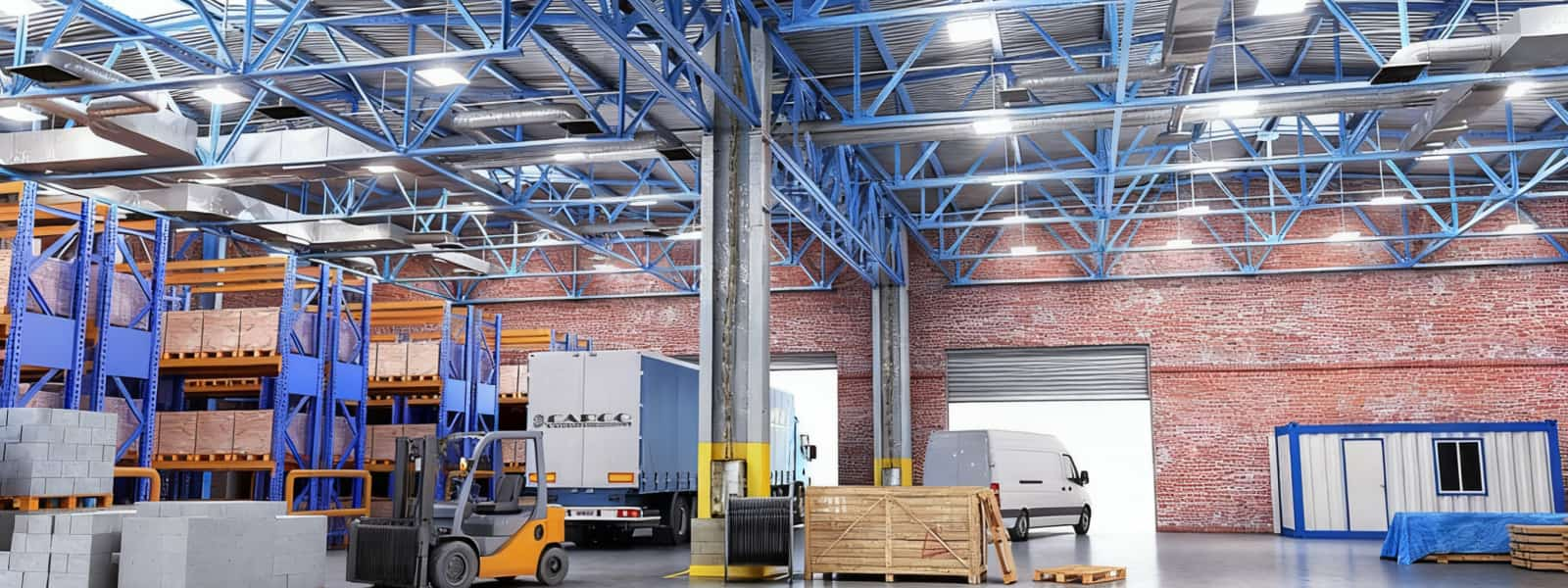
“What Is New in Industrial LED Lighting in 2025?” This is a question frequently asked by many. In this fast-evolving era, people fear being left behind and are eager to find out about the latest technological developments.
Below, this article breaks down the key updates—organized into the following sections—to give you a clear overview:
Table of Contents
Market Shift & Industry Landscape
Breakthrough Product Categories
Sustainability & Green Manufacturing
Market Shift & Industry Landscape
Industrial lighting is no longer just about replacing metal halide or fluorescent lamps to save electricity. In 2025, LED lighting has evolved into a core infrastructure for digital manufacturing, energy management, and workplace safety.
1. From Light Replacement to Smart Asset
Over the past decade, companies adopted LEDs mainly to reduce power consumption and maintenance costs. Today, the focus has shifted. Industrial LED lighting is now treated as a strategic asset — a system that collects data, supports automation, and aligns with carbon reduction goals.
2. Policy and Energy Pressure Drive Adoption
Several global forces are accelerating this shift:
Mercury bans and RoHS regulations are phasing out HID and fluorescent fixtures.
Carbon neutrality commitments in the EU and U.S. demand measurable energy savings in factories and warehouses.
Rising electricity prices push industrial operators to upgrade to high-efficiency lighting systems.
Standards like ISO 50001 and EN 12464-1 require better illumination, energy tracking, and worker safety.
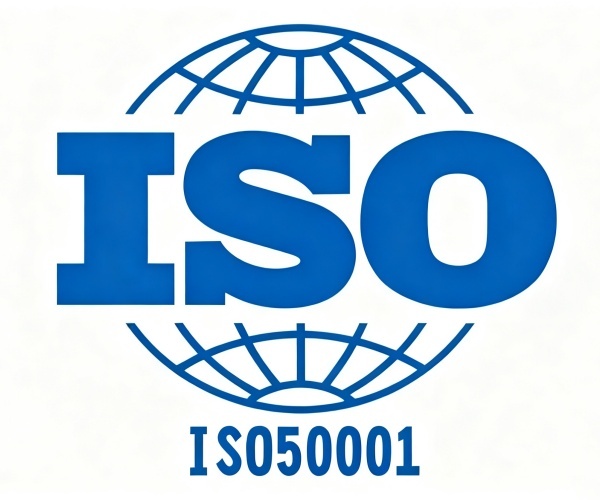
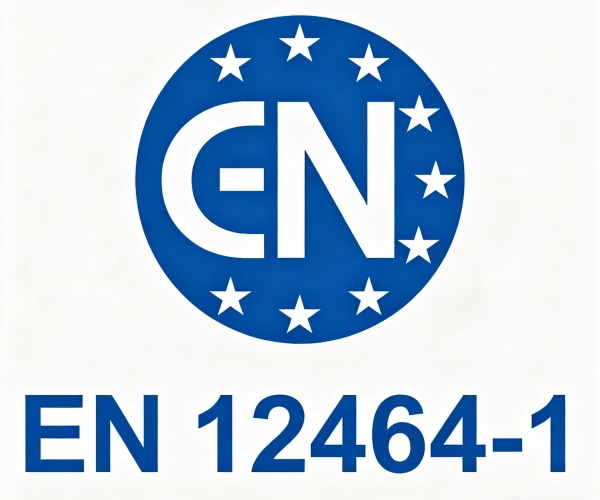
3. Industries Leading the Change
Some sectors are moving faster than others:
Manufacturing and automotive plants are deploying smart lighting linked to production lines.
Warehousing and e-commerce logistics centers adopt LED high bays like Ceramiclite’s HB01 to cut costs and enable motion-sensing control.
Cold storage chains prefer LEDs for low-temperature efficiency and instant start-up.
Ports and heavy industry sites upgrade lighting for higher visibility, durability, and remote monitoring.
Core Technology Innovations
Industrial LED lighting has moved far beyond “energy-efficient replacements.” Today’s systems are intelligent, adaptive, data-driven, and built to withstand some of the harshest environments on earth. Below are the core technologies shaping this shift.
1. Smart Control & IoT
Lighting is now a connected asset, not just a fixture.
How it works:
Each luminaire can be equipped with sensors (motion, occupancy, ambient light) and a wireless communication module (Bluetooth Mesh, Wi-Fi, Zigbee).
These fixtures send data (usage, temperature, power consumption) to gateways or cloud platforms, where facility managers can monitor and control lighting through dashboards or apps.
Combined with AI, the system identifies abnormal patterns (flicker, overheating capacitors, lumen drop) and triggers predictive maintenance instead of reactive fixes.
Practical gains:
Up to 60% extra energy savings beyond LEDs alone.
Zoning and task lighting—workstations stay bright, idle aisles automatically dim.
Integration with HVAC, conveyors, and BMS systems improves overall factory automation.
2. Human-Centric Lighting (HCL)
Lighting is now designed for people—not just machines and energy bills.
What’s changing:
Tunable white technology (3000K–6500K) adjusts lighting color based on time of day or task type.
High CRI (Ra 90+) and low UGR optics improve color accuracy and reduce glare on metal, glass, or reflective surfaces.
Circadian lighting algorithms mimic natural sunlight cycles, reducing fatigue in workers, especially in 24/7 factories, cold storage, or underground facilities.
Why it matters:
Up to 5–10% productivity improvement reported in manufacturing and packaging lines.
Fewer visual errors and reduced accident rates in high-risk zones (press machines, forklift routes).
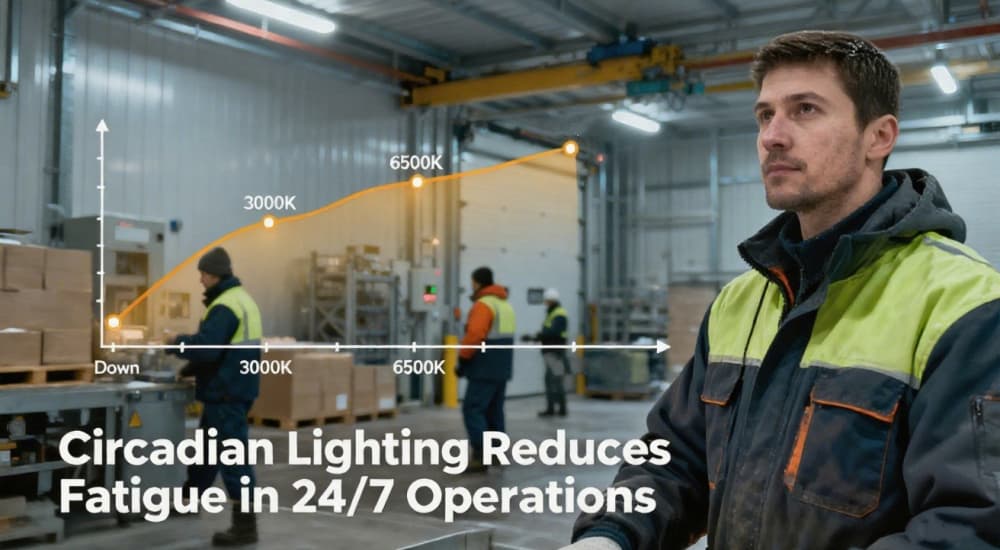
3. High-Efficiency & Optical Upgrades
Modern LEDs are pushing physical limits, not just replacing fluorescent tubes.
Efficiency leap — how it’s achieved:
Technology | Function |
GaN (Gallium Nitride) power devices | Higher voltage tolerance and lower heat loss than silicon drivers. |
COB / Multi-chip LED modules | Higher lumen density and better thermal conduction. |
Driver efficiency (≥92%) | Reduces wasted power and increases system lifespan. |
150–200 lm/W output | Now standard in high-bay fixtures; COB modules can exceed 200 lm/W. |
Optical innovation:
Modular lenses allow beam angles from 15° focused beams (racking aisles) to 120° wide floods (open workshops).
TIR lenses, prismatic diffusers, asymmetric optics reduce hotspots and deliver uniformity over large areas.
High mast & port lighting now uses multi-layer optics to control beam spill and prevent glare for crane operators and drivers.
4. Extreme Durability & Outdoor Adaptation
Industrial lighting must survive dust, vibration, steam, oil, salt, rain, -50°C winters, and +80°C furnace heat. Outdoor use pushes these limits even further.
Indoor + Outdoor durability technologies:
Feature | Why it matters |
IP65–IP69K sealing | Blocks dust, moisture, and high-pressure washing (food plants, mining sites). |
IK10 impact resistance | Prevents damage from forklifts, tools, vibration, or hail. |
-50°C to +85°C operating range | Works in freezers, steel mills, desert warehouses. |
Salt-spray & anti-corrosion coating | Necessary for ports, coastal factories, chemical plants. |
Explosion-proof enclosures (Ex d IIC T6) | Mandatory in oil refineries, gas stations, paint workshops. |
Outdoor industrial lighting — beyond factory walls:
Industrial lighting is increasingly used outside the building, especially in:
Perimeter walls and facades → wall-mounted up/down lights
Loading docks and outdoor workstations → pole lights with motion sensors
Storage yards & container terminals → high-mast lights with photocells or smart scheduling
Parking areas & logistics yards → pole lights with dusk-to-dawn sensors and anti-glare shields
These outdoor-rated fixtures ensure:
Stable brightness in fog, rain, or night-shift environments
Worker safety through anti-glare lenses and uniform illumination
Compliance with OSHA, EN 12464-2, and maritime safety standards
✅ Summary
Industrial lighting innovations in 2025 are defined by four pillars:
Smarter control, human-focused lighting, higher optical efficiency, and extreme durability both indoors and outdoors.
These technologies are transforming lighting systems into intelligent infrastructure rather than passive utilities.
Breakthrough Product Categories
Industrial lighting is no longer a one-size-fits-all market. Instead, manufacturers are developing specialized fixtures tailored for extreme temperatures, corrosive environments, high ceilings, or automated logistics facilities.
Below are the product types leading this transformation.
1. High-Temperature LED Lights
Traditional LEDs struggled in high-heat environments due to driver failures and lumen decay. New-generation high-temperature fixtures solve this with:
Independent heat dissipation chambers separating drivers from LED chips
COB (Chip-on-Board) LED modules for higher thermal conductivity
Materials rated for 70°C–80°C ambient temperatures, some even reaching 100°C with external drivers
Used in: steel mills, glass factories, drying rooms, foundries, Middle East outdoor facilities.
2. High Bay Lights – UFO & Linear
High bay lighting is evolving beyond basic illumination. The new generation combines efficiency, intelligence, and easier installation.
What’s new:
150–170 lm/W efficacy, reducing fixture count in large warehouses
Millimeter-wave or microwave sensors for motion and daylight detection
Tool-free modular design, enabling installation in minutes
Optional uplight or emergency battery modules for safety compliance
For facilities upgrading high-bay systems, products like Ceramiclite’s HB01 illustrate how modern fixtures integrate high efficiency, optional sensor control, and durable construction—yet this is just one example of many next-generation solutions available in the market.
Used in: warehouses, manufacturing plants, logistics centers, sports arenas.
3. LED Flood & Area Lights
These lights are now built to handle harsh outdoor and industrial environments with precision and safety.
Key innovations:
Asymmetric light distribution to reduce glare and avoid light spill
Explosion-proof and ATEX-rated versions for petrochemical and mining zones
IP67–IP69K protection, ensuring resistance to high-pressure cleaning, sea air, and dust storms
Adjustable brackets & modular drivers for easy field maintenance
Used in: ports, construction sites, open-pit mines, loading docks, railway yards.
4. Tri-proof Industrial Lights (Waterproof, Dustproof, Corrosion-proof)
These lights are designed for environments involving moisture, chemicals, and continuous cleaning.
What’s new:
Sapphire or tempered glass covers instead of plastic to avoid yellowing
IP69K + IK10 ratings, supporting high-pressure washdowns and impact resistance
Anti-ammonia and anti-salt spray coatings for food processing and chemical plants
Series connection and quick wiring systems to reduce installation time
Used in: food processing facilities, tunnels, car washes, chemical factories, cold storage.
5. Sensor-Integrated & Networked Lighting
Lighting has become part of the industrial IoT ecosystem.
Core upgrades:
Built-in motion, occupancy, or ambient light sensors in each lamp
Bluetooth Mesh, Zigbee, or DALI-2 wireless networking for group control
Mobile app or cloud platform management for scheduling and real-time data
Energy reporting, fault alerts, and predictive maintenance dashboards
Used in: smart factories, automated warehouses, logistics hubs, robotic distribution centers.
✅ Why This Matters
Each product category addresses a specific industrial challenge—heat, dust, scale, automation, or safety. Together, they show how industrial lighting has evolved from general-purpose illumination to a system of specialized, mission-critical solutions.
Sustainability & Green Manufacturing
Sustainability in industrial lighting is no longer a marketing trend—it is driven by regulation, corporate ESG responsibilities, and long-term operational cost control. LED manufacturers and end users are aligning with global standards such as the EU RoHS, WEEE, and the Minamata Convention on Mercury, which officially bans mercury-based lighting in many regions.
(1) Modular, Repairable, and Recyclable Design
Modern industrial fixtures are shifting away from “sealed and disposable” structures toward products designed for long-term maintenance and recycling.
Modular drivers, LED boards, and optics can be replaced independently, reducing electronic waste.
Aluminum housings and polycarbonate lenses are now designed for material recovery at end of life.
Some manufacturers provide disassembly instructions and lifecycle documentation for ESG reporting.
(2) Energy Savings and Carbon Reduction
Energy reduction is still the core metric of sustainability.
LED systems cut electricity use by 50–80% compared to metal halide or fluorescent lamps.
Smart dimming, motion sensors, and daylight harvesting push savings even higher in low-occupancy areas like warehouses and logistics centers.
Lower power demand also reduces HVAC load—less waste heat means lower cooling costs in summer.
(3) Solar + LED + Energy Storage Systems
For remote areas and energy-intensive industrial zones, solar-based lighting solutions are emerging fast.
Solar panels + LED luminaires + lithium or LiFePO₄ battery packs enable autonomous, off-grid operation.
Used in ports, parking areas, remote factories, mining camps, oil fields, and regions with unstable grid supply.
New systems include smart inverters and MPPT controllers for real-time power optimization.
(4) Mercury-Free and Low Light Pollution Compliance
LED lighting naturally complies with the Minamata Convention, eliminating mercury pollution caused by traditional fluorescent or HID lamps.
RoHS standards limit lead, cadmium, and other hazardous substances.
Industrial LED optics now apply shielding, glare control, and dark-sky compliant beam designs to reduce light spill, particularly in ports and outdoor logistics hubs.
(5) ESG Reporting and Lifecycle Transparency
Large industrial users—automotive, logistics, semiconductor factories—are now required to document lighting energy consumption and emissions:
Lighting management platforms generate energy reports for GHG Protocol and ISO 50001 compliance.
Fixtures are rated with LM-80 and TM-21 lifetime data, making ROI and sustainability measurable.
Some suppliers offer carbon footprint per fixture (kg CO₂e/unit) as part of procurement documentation.
✅ Key Takeaway
Industrial lighting is now designed not just to save kilowatts, but to meet regulatory compliance, reduce lifetime waste, support renewable power systems, and enable traceable ESG reporting. Sustainability has become a built-in requirement—not an optional feature.
Business Model Innovations
Industrial lighting is no longer just about selling fixtures. New service-oriented and data-driven models are reshaping how factories, warehouses, and logistics facilities invest in lighting systems.
1. Lighting-as-a-Service (LaaS)
Instead of buying equipment outright, companies are subscribing to lighting.
No upfront investment – installation, fixtures, and commissioning are covered by the provider.
Monthly or yearly payment plans based on actual usage or operating hours.
Maintenance and upgrades included, eliminating unexpected repair costs.
Ideal for large facilities aiming to transition to LED without disrupting cash flow.
2. Digital Twin & Lighting Management Platforms
Lighting is becoming a digital asset that can be monitored and controlled like any other industrial system.
A digital twin creates a live virtual model of the facility’s lighting network—showing fixture status, power consumption, and failure risks.
Cloud energy monitoring tracks kWh usage by zone, shift, or production line.
ESG auto-reporting tools export data aligned with ISO 50001, GHG Protocol, or corporate sustainability reports.
3. Predictive Maintenance
Repairs are shifting from reactive to intelligent.
Sensors and IoT platforms collect data on temperature, current, and driver performance.
AI algorithms predict failures before they happen, reducing downtime by up to 30–40%.
Maintenance teams receive alerts and replacement schedules directly through mobile or facility management systems.
This minimizes labor costs, prevents dark spots, and extends LED lifespan.
✅ Why It Matters
These innovations turn lighting from a fixed asset into a managed service—measurable, upgradeable, and aligned with financial planning and ESG commitments. Businesses no longer buy lights; they buy performance, uptime, and energy data.
Challenges & Future Trends
1. Current Challenges
● Supply Chain & Rare Material Dependency
The LED industry still relies heavily on imported high-efficiency chips and rare-earth phosphors. Price fluctuations in indium, gallium, and thermal interface materials continue to increase production costs and pressure manufacturer margins.
● Fragmented IoT Protocols
Smart lighting is no longer a technological barrier — interoperability is. Zigbee, DALI, Bluetooth Mesh, Wi-Fi, KNX, NB-IoT and proprietary protocols coexist, and systems often cannot communicate with each other. This forces project contractors to invest in additional gateways and integration software, increasing installation and maintenance complexity.
● Market Saturation → Shift from “Brighter” to “Smarter”
Simply offering higher lumen output or lower energy consumption is no longer enough. In a mature and saturated market, buyers (especially industrial and commercial facility owners) are prioritizing smart control, predictive maintenance, energy reporting, and system integration rather than just wattage and brightness.
2. Future Trends
● AI-Powered Adaptive Lighting Systems
Industrial LED light fixtures will work with sensors and AI platforms to analyze occupancy, daylight, production schedules, and generate automatic dimming, energy optimization, and real-time reports without manual intervention.
● Li-Fi (Light-Based Wireless Communication)
LED lighting will also function as a data transmitter. Li-Fi enables high-speed communication through light waves with zero electromagnetic interference — ideal for hospitals, aircraft cabins, cleanrooms, mines, and other Wi-Fi-restricted environments.
● MicroLED & GaN Power Electronics
MicroLED pushes efficiency, contrast, and lifespan beyond traditional SMD LEDs. At the same time, GaN (Gallium Nitride) drivers are replacing silicon MOSFETs, allowing higher power density, lower heat, and smaller driver size in high-bay and floodlighting applications.
● Lighting + Energy Storage Systems
Solar panels, LED luminaires, and lithium battery storage are being combined into independent, off-grid lighting solutions for ports, mines, oilfields, and remote construction sites. Some manufacturers already integrate this into Lighting-as-a-Service (LaaS) models.
● Repairable, Recyclable & Circular Economy Design
Future LED products must be modular, field-repairable, and recyclable. Replaceable drivers, COB boards, and aluminum housings aligned with EU RoHS and the Minamata Convention will become standard, not optional.
Conclusion Direction
Industrial lighting is no longer just equipment — it has evolved into a core part of smart infrastructure. What used to be a simple light source is now a data-driven system that connects energy management, worker safety, automation, and sustainability.
The new value of industrial lighting lies in five key dimensions:
Smart (sensor-based control, cloud platforms, AI automation)
Efficient (150–200 lm/W, optimized energy use, predictive maintenance)
Human-Centric (visual comfort, low glare, correct circadian lighting)
Sustainable (recyclable materials, energy storage, solar integration, RoHS compliance)
Reliable (high IP ratings, heat resistance, long life cycles)
For businesses, early adoption is not just a technological upgrade — it directly translates into:
Lower energy bills and operating costs
Better workplace safety and productivity
Faster ROI and predictable lifecycle budgets
Stronger ESG performance and regulatory compliance
Industrial lighting is entering its next decade — not defined by how bright it can get, but how intelligent, sustainable, and future-ready it can become.
_thumb.jpg)
